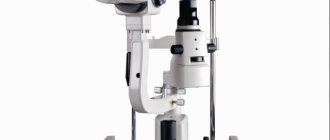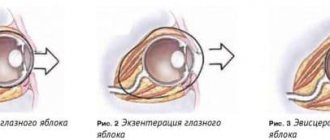To diagnose ophthalmological diseases, several methods are used in parallel using various automatic and semi-automatic devices. Such devices take readings more accurately and eliminate the risk of medical errors.
Among such devices are an autorefractometer and an autorefractometer. They are used during examinations in cases of changes in the shape of the cornea, which leads to a decrease in visual acuity.
autorefkeratometer
What is autorefractometry?
Autorefractometry is a computer procedure that examines the cornea of the eye to determine diseases such as myopia, farsightedness, and astigmatism. The beauty of this procedure lies in the speed and accuracy of the results. The device accurately and in a short time determines what the refraction of the eye is. This allows both adults and children to undergo the procedure. What kind of procedure is this? Let's discuss the issue in more detail.
Refraction of the eye is a complex process that is determined by a living optical system. In other words, the human eye is too complex. We can see because the light beam penetrates the cornea, then it reaches the anterior chamber and lens, and only then the vitreous body, which refracts the light so that it is focused on the retina. An interesting fact: at the moment when light hits the retina, the image is perceived upside down, and only after it is transformed into impulses does the familiar image appear in front of us. If it were not for this property, then a person would perceive the world around him upside down.
Aberrations of the eye
“Aberration is any angular deviation of a narrow parallel beam of light from the point of ideal intersection with the retina at the center of the foveola as it passes through the entire optical system of the eye.”
Wavefront passing through an ideal and non-ideal optical system: ideal (top) and real (bottom) refractive pattern in the geometric optics approximation
To describe refraction and select correction, parameters such as sphere, cylinder and cylinder axis are traditionally used, and the measurement of refractive errors of the eye was reduced to obtaining information from a single point. The development of science has made it possible to determine high-order aberrations and their distribution, and modern technologies have made it possible to take them into account when selecting corrections and forming the design of spectacle lenses.
The human eye, like any “imperfect” optical system, has optical defects - aberrations that reduce the quality of vision by distorting the image on the retina. Aberration is any angular deviation of a narrow parallel beam of light from its ideal intersection with the retina at the center of the foveola as it passes through the entire optical system of the eye.1
The shape of the wave front depending on the type of ametropia: 1 – flat wave front; 2 – converging wave front; 3 – diverging wave front
In technical optics, the quality of an optical system is determined by the aberrations of the plane or spherical front of a light wave as it passes through this system. In ophthalmic optics, the wavefront is the shape of the optical surface that includes all the aberrations of the eye. Each person's wavefront is as unique as their fingerprint.
An eye without aberrations has a flat wave front and gives the most complete image of a point source on the retina. But in reality, even with high visual acuity, optical defects in the light-refracting surfaces of the eye distort the path of rays and form an incorrect wave front, resulting in a larger and asymmetrical image on the retina. The main source of spherical aberration in the eye is the lens, followed by the cornea. The wider the pupil, that is, the larger part of the lens takes part in the visual act, the more noticeable the spherical aberration.
Zernike polynomials
A mathematical method for describing image defects or aberrations in optical systems in the form of a series of polynomials was proposed by the Dutch physicist Fritz Zernike (1888-1966). A polynomial is a polynomial, an algebraic expression that represents the sum or difference of several monomials. Polynomials of the first and second, that is, lower, orders describe optical aberrations familiar to ophthalmologists - defocusing (ametropia), astigmatism. Third-order polynomials correspond to coma - a spherical aberration of oblique beams of light incident at an angle to the optical axis of the eye. Fourth-order aberrations include spherical aberration, which is mainly due to the fact that the periphery of the lens refracts parallel rays incident on it more strongly than the center.
The polychromatic nature of light causes chromatic aberrations to occur when rays of different wavelengths are focused at different distances from the retina (short-wavelengths are closer to the cornea than long-wavelengths).
1 When writing this section, the material from the article was used: Egorova G. B., Borodina N. V., Bubnova I. A. Aberrations of the human eye, methods of their measurement and correction (literature review) // RMJ [Site]. URL: https://rmj.ru/articles_4917.htm (access date: 02/07/2014).
Refractive Study
If we consider the word “refraction” itself, it will mean the ability of the eye to refract light. In order to indicate refraction, a measurement system such as diopters was introduced. If we are talking about measuring refraction in an ophthalmologist's office, then a clinical action is implied, while in a natural environment the refraction will be natural, physical. Clinical research allows accommodation to be taken into account. Thanks to this ability, a person has the opportunity to focus his gaze on an object, regardless of its distance. Tests carried out in the doctor's office reveal accommodation and determine how thoroughly this function is performed. Thus, we can conclude what autorefractometry is in ophthalmology. This is an objective method of assessing the characteristics of the cornea of the eye and its ability to absorb and reflect light rays.
Operating principle of standard autorefkeratometers
Most autorefkeratometers operate on the principle of analyzing the emission of infrared (IR) light. Light passes through the eye twice: when entering the eye and when leaving it. Electronic sensors record the image of this beam. The beam parameters are analyzed using special computer programs, and the result is a refraction value. Different devices use different optical principles.
Standard autorefkeratometer: 1 – mirror; 2 – first lens; 3 – mirror with holes; 4 – diaphragm; 5 – LED; 6 – measuring diaphragm; 7 – prism; 8 – CCD matrix; 9 – camera lens
Calculation of refraction parameters (Sph, Cyl, Ax) using a standard autorefractometer
A standard autorefkeratometer takes measurements at six points in the center of the pupil, then analyzes the IR light reflected from the retina and calculates parameters such as sphere, cylinder and cylinder axis based on data at the two main meridians. When using standard instruments, measuring refractive errors of the eye is reduced to obtaining information from a single point, and high-order aberrations are not taken into account, and there is also no data on volumetric resolution.
The latest generation of autorefractometers operate on the principle of wavefront analysis (wave aberrometry). With the help of such devices, all aberrations of the eye, including high-order aberrations, can be measured, recorded, analyzed and displayed.
Research methods
Refraction of the eye is a basic concept for an ophthalmologist. It is thanks to the indicators of the performed autorefractometry that it is possible to identify deviations in the functioning of the visual apparatus. Therefore, this procedure has gained incredible popularity in clinical medicine. Carrying out the examination is impossible without a special device - a refractometer. This device independently conducts the test and produces a result, for which, in fact, autorefractometry was carried out. The result is interpreted by an ophthalmologist. He looks at the refractive index, determines the diameter and functionality of the cornea, and also calculates the radius of curvature deviation.
In order for the result to be accurate, it is necessary to exclude all factors that irritate the eye. This is necessary so that the eye is calm and nothing disturbs it, because excessive muscle contraction can lead to an incorrect result, which will lead to unpleasant consequences. To avoid this, the patient is asked to focus on a picture that is very far away. An interesting fact: previously a simple dot was used as such a picture, now in new devices an image of a ball or a Christmas tree appears, which allows the device to determine the parameters more accurately.
Interpretation of a sample printout of measurements on a Huvitz HRK-8000A autorefractometer
1 - refractometry results;
2 - right eye;
3 - left eye;
4 - optical power of a spherical lens, diopter, corresponding to the refraction of the eye in one of the two main meridians of the eye;
5 - results of measuring the radius of curvature of the cornea in its maximum and minimum meridians, expressed in millimeters;
6 - results of measurements in the maximum and minimum meridians of the cornea;
7 - interpupillary distance, mm;
8 - vertex distance, mm;
9 - type of cylinders (negative);
10 - optical power of a cylindrical lens, the addition of which to a spherical lens with an optical power corresponding to one of the two main meridians of a given eye, displays the refraction of the eye in the other main meridian; usually negative (minus) cylinders are preset in the settings of autorefractometers;
11 - axis of the cylindrical lens, deg. (see item 10);
12 - the average measurement of refraction in the two main meridians of the eye, expressed as a prescription for glasses;
13 - keratometry results;
14 - the average indicator of the obtained measurements of the radius of curvature of the cornea, mm, and refractive power, diopters, in its minimum and maximum meridians;
15 - results of measuring the corneal refraction, diopters, in its minimum and maximum meridians.
Operating principle of the device
While the patient is looking intently at the image, the doctor starts the device and autorefractometry begins. What it is, the person being studied may not even understand. For him, the process will be painless and will not cause discomfort. An infrared beam sent into the eye is refracted several times until it reaches the fundus and retina. After that, it seems to be reflected from there and returns back. The time it takes for the beam to return is the main parameter. This technique became available only with the advent of the refractometer, because a person cannot cope with this task.
Medmart LLC - autorefkeratometers of the best models
Autorefkeratometer is a modern ophthalmological equipment that is designed for eye refraction. Allows you to accurately measure the interpupillary distance, determine the width of the pupil and the curvature of the cornea.
This important information is used in the selection of glasses and lenses, so the devices themselves are installed not only in clinics and diagnostic centers, but also in opticians.
Investments in equipment quickly pay off, and specialists will have access to an effective and reliable diagnostic device, which greatly facilitates the work of medical staff.
Features of autorefkeratometers
Keratometry and refraction are measured automatically, so there is no negative influence of the human factor and associated errors. Main advantages:
- High accuracy. The equipment has no equal in this parameter. The price of the Huvitz autorefkeratometer is fully justified by its versatility and high reliability of the data obtained.
- Versatility. The more expensive the model, the more parameters it can measure. Additional features include retroillumination. By pressing a special button, the doctor can detect clouding of the vitreous body, lens or cornea in transmitted light.
- Efficiency. Diagnosis requires very little time, the patient does not experience discomfort or get tired.
- High profitability. Nowadays, many opticians decide to buy a Huvitz or another manufacturer's autorefkeratometer for promotional purposes. Such devices are installed in shopping centers with high foot traffic, where everyone is offered a free check.
Diagnostics on the equipment allows not only to select glasses with complex lenses. It plays a special role in determining important characteristics of the visual organs before elective surgery, refractive or catarrhal eye surgery.
What do experts recommend?
The Huvitz autorefkeratometer has managed to win the trust of many leading experts. They demonstrate reliability and practicality. Regardless of the model, Huvitz devices are easy to use and multifunctional. In addition, they have an attractive and fairly ergonomic design. It's really nice to work with such devices.
The designs include a Shack-Hartmann sensor. The study involves wave analysis of light rays reflected from the retina of the eyes.
Advantages of autorefractometry
Humanity has long appreciated the benefits of autorefractometry. Everyone should know what it is, because it allows you to assess the initial stage of eye deformation and notice deviations. Autorefractometry, the norms of which are clearly defined and marked, is easily carried out in large diagnostic centers, so try to get an appointment with a doctor who has the above-mentioned device.
Also, the big advantages of the procedure are:
- confirmation of farsightedness and myopia;
- obtaining clear parameters;
- the ability to obtain data on anisometropia and its degree;
- speed and accuracy of research.
What is the difference between an autorefractometer and an autorefractometer?
Autorefractometer and autorefractometer are very similar in name, but have completely different purposes:
- The first is used to identify diseases associated with vision indicators. Helps identify diseases such as myopia, hypermetropia, astigmatism, etc.
- The second device helps you choose the right individual optical lenses and glasses.
The cost of a set of which is optimal, systems that will reduce the time to see one patient and improve the quality of service. Buy a manual refractometer, the price corresponds to the efficiency. In addition, we have ophthalmoscopes.
The modern market is filled with models of equipment, divided depending on technical characteristics and methods of use. If you decide to buy an autorefractometer, you can make a purchase in our online store.
Our consultants will help you choose the right device; you can contact us through any convenient communication channel listed on the website. Both devices optimize the diagnostic process for the modern ophthalmologist.
What types of automatic refractometers are there:
- stationary
- portable.
A stationary autorefractometer will become an indispensable assistant - as the main equipment. Portable autorefractometers will be needed for visiting patients at home and for examining children. Compact dimensions make them easy to carry and use.
Our catalog also includes a pediatric autorefractometer. This is a refractometer of the specified type, which is applicable for examining children from the age of three months, and will allow you to easily determine the state of eye health of even the youngest patients without any extra effort.
Our website displays an impressive selection, including retinoscopes. It is possible to order and buy a manual autorefractometer from us inexpensively, with delivery.
All devices presented by our company are certified and comply with international quality standards. The main difference between a children's portable autorefractometer is the price, our company offers the optimal one.
Source: https://AlmaMed.su/category/avtorefraktometry/
Errors and nuances
The only nuance that must be taken into account before performing autorefractometry is the passage of light through the cornea. The fact is that the procedure will be useless if there is clouding of the cornea or other part of the eye. This is not surprising, because the main evaluation criterion is the speed of return of the light beam, which means that the purity of the experiment depends on the initial state of the organ of vision.
Measuring the speed of return of the light beam allows you to get a clear and reliable result. At the moment, this procedure is recognized as the most accurate of the existing ones. Having understood the concept of autorefractometry, what it is and how it is carried out, you can safely go to an appointment with an ophthalmologist.
Subjective and objective methods for determining refraction
There are two main groups of methods for determining refraction: objective and subjective. Subjective methods are based on the analysis of the patient’s feelings and are rooted in the distant past. Before the invention of the trial lens set by the German scientist Frohnmuller in 1843, ready-made glasses were sold by itinerant traders. The selection of the required glasses was carried out by the buyers themselves. They chose from the merchant's tray those in which it was convenient to look into the distance or read. With the advent of the trial set, sellers of ready-made glasses began to advise customers, helping them select the lenses that suit them. The decision on the correctness and completeness of vision correction was made based on the patient’s subjective feelings. Today, to study the subjective refraction of the eye, sets of trial spectacle lenses and prisms, trial frames and, of course, various tables with optotypes are used.
However, accurate selection of correction using subjective methods alone is quite labor-intensive and is not possible in all cases. Therefore, objective methods for studying refraction have been proposed, in which the patient’s subjective feelings do not play a role. These methods include retinoscopy and autorefractometry.
Retinoscopy, or skiascopy, is based on observing the movement of the shadow in the area of the pupil under various methods of illumination. In refractometry, an infrared beam of light reflected from the retina is analyzed, the focusing of which depends on the type and degree of refraction. During autorefractometry, data is obtained automatically with subsequent mathematical processing.
We must remember that turning to objective methods of studying refraction is only the initial stage in its determination and selection of glasses, after which there must also be a “subjective” study. Only in exceptional cases where the latter cannot be carried out, for example when examining infants, small children or other patients unable to communicate, can the results of an objective examination be used to issue a prescription.











